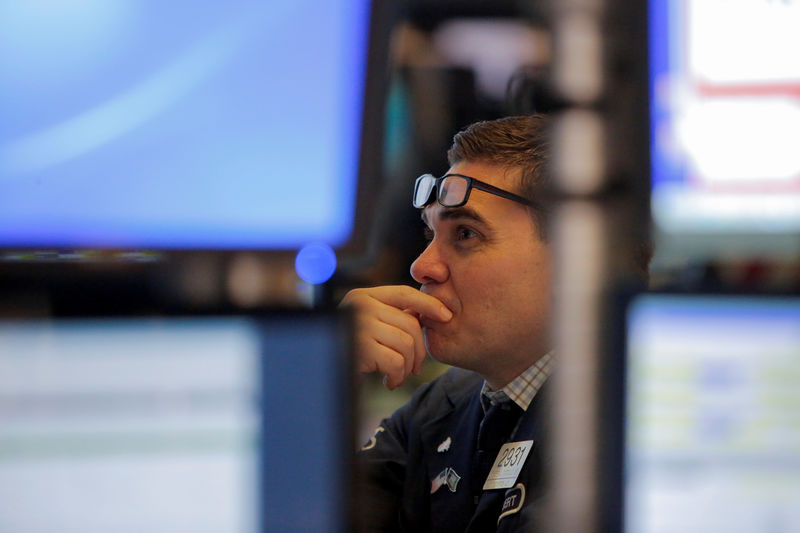
© Reuters.
By Geoffrey Smith
Investing.com — Monetary policy concerns keep the dollar firm and short-dated bonds weak at the start of a busy week for central bank meetings. The ISM business survey is due and may cement expectations of the Federal Reserve having to hike rates sooner than expected (Goldman Sachs (NYSE:GS) now sees the first hike as early as July next year). China’s economy sends out mixed signals but the real estate crisis is – at best – grinding on. The COP26 climate conference seems set to be an anticlimax after G20 leaders failed to agree on how to accelerate the phase-out of coal, and oil prices are pushing higher ahead of this week’s OPEC+ meeting. Here’s what you need to know in financial markets on Monday, 1st November.
1. Dollar firm as Goldman warns of faster rate hikes
Expectations of tighter monetary policy are front and center in investors’ minds at the start of a week that is likely to see landmark decisions to wind down the stimulus that sustained the economy through the pandemic.
The U.S. Dollar is consolidating close to the highs it posted on Friday after data showed prices for personal consumer expenditures – the Federal Reserve’s favored measure of inflation – rising at 4.4% annually, the fastest in years. Two-Year U.S. bond yields topped 0.5% for the first time in 19 months in response, while analysts at Goldman Sachs moved up their forecast for the first Fed rate hike by a year to July 2022.
The PCE basket showed that price increases, which had been confined to a few sectors earlier in the year, had broadened significantly. Those data may or may not be corroborated by the ISM manufacturing survey, due at 10 AM ET (1500 GMT).
The Fed’s two-day policy meeting begins on Tuesday, and is expected to end with an announcement on phasing out the central bank’s bond purchases, which are currently running at $120 billion a month.
2. China’s PMIs send mixed signals; real estate crisis grinds on
Two closely-watched Chinese business surveys sent out mixed signals, with the official purchasing managers index suggesting that manufacturing activity had contracted in October under the weight of fuel shortages, anti-pollution measures and ongoing Covid-19-related disruptions to production.
The private-sector Caixin PMI, however, rose to 50.6 from 50.0 in September, offering some reassurance. Even so, junk bond yields rose to their highest since 2009 and Iron ore Futures fell as much as 4% amid continuing fears for the outlook of the real estate sector.
Another top-20 developer by size, Yango Group, said on Monday it was looking to extend payment on three of its dollar bonds, sending its shares down 9% in Shenzhen.
Elsewhere in Asia, the Nikkei rose over 2% in response to an emphatic election win for Japan’s new Prime Minister Fumio Kishida, who promptly promised a large-scale stimulus program. South Korea’s trade numbers showed exports up 24% on the year, a little less than expected.
3. Stocks set to open higher; Coke, American in focus
U.S. stocks are set to open at new record highs later, on broad-based optimism about the economic recovery – albeit volume may be lower than usual due to the shadow cast by the approaching Fed meeting.
By 6:05 AM ET (1105 GMT), Dow Jones futures were up 154 points, or 0.4%, while S&P 500 futures were also up 0.4% and Nasdaq 100 futures were up 0.3%
Stocks likely to be in focus later include Coca-Cola (NYSE:KO) and PepsiCo (NASDAQ:PEP), after The Wall Street Journal reported that Coke is to buy out the rest of sports drink maker BodyArmor, upping its efforts to challenge the dominance of Pepsi’s Gatorade. Also in focus will be American Airlines (NASDAQ:AAL), after weather and tight staffing rosters snarled its weekend flying schedule, and gaming platform Roblox (NYSE:RBLX), which was hit by a lengthy outage over the weekend.
4. COP26 set for anticlimax
Coal lives to fight another day, after the G20 Group of Leaders from industrialized and emerging nations failed to agree on new proposals to phase it out of the world energy mix at their meeting on Saturday.
That lack of unity is likely to frustrate the efforts of negotiators at the COP26 climate conference this week, which will be forced to confront the unwelcome reality that most of the pledges made under the 2015 Paris Climate Accord have not been honored.
Efforts to step up the fight against climate change have been thrown into disarray over the last two years by the pandemic and by the subsequent surge in global energy prices as world manufacturing recovered from it faster-than-expected. That has resulted in carbon dioxide emissions quickly returning to their pre-pandemic trend.
5. Oil pushes higher ahead of OPEC+ meeting
Crude oil prices rose in overnight trading, supported by a broadly positive tone in risk assets that also lifted European stocks to new highs for the year.
By 6:25 AM ET, U.S. crude futures were up 0.6% at $84.03 a barrel, while Brent futures were up 0.9% at $84.50 a barrel. The differential between the two narrowed sharply at the end of last week, after data from the Energy Information Administration showed a decline in U.S. production, further tightening the local supply-demand balance.
Reports continue to bubble about the OPEC+ meeting on Thursday, but an increase in output above and beyond the 400,000 barrels a day already outlined seems unlikely: OPEC’s Joint Technical Committee cut its expectations for 2021 demand last week, although it left its 2022 forecast unchanged.
Source: Investing.com








![[Geojit Comtrade] Daily report on Natural Rubber: December 4, 2012](https://img.globalrubbermarkets.com/2024/08/geojit-comtrade-daily-report-on-natural-rubber-december-4-2012.jpg?resize=120%2C86&ssl=1)


















